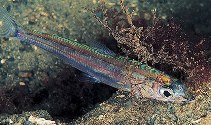Add your observation in Fish Watcher
| Native range | All suitable habitat | Point map | Year 2050 |

|
| This map was computer-generated and has not yet been reviewed. |
| Argentina sphyraena AquaMaps Data sources: GBIF OBIS |
Upload your photos and videos
Pictures | Google imageArgentina sphyraena
Picture by Svensen, E.
Pictures | Google imageArgentina sphyraena
Picture by Svensen, E.
Common names from other countries
Classification / Names Nombres comunes | Sinónimos | Catalog of Fishes(Género, Especie) | ITIS | CoL | WoRMS | Cloffa
> Argentiniformes (Marine smelts) > Argentinidae (Argentines or herring smelts)
Etymology: Argentina: Latin, argentus = silver (Ref. 45335).
More on author: Linnaeus.
Etymology: Argentina: Latin, argentus = silver (Ref. 45335).
More on author: Linnaeus.
Environment: milieu / climate zone / depth range / distribution range Ecología
marino batidemersal; rango de profundidad 50 - 700 m (Ref. 56504). Deep-water; 71°N - 24°N, 19°W - 36°E
Distribución Países | Áreas FAO | Ecosistemas | Ocurrencias, apariciones | Point map | Introducciones | Faunafri
Eastern Atlantic: northern Norway to Western Sahara including southern Iceland, Faroe Islands, Shetlands and Mediterranean.
Tamaño / Peso / Age
Maturity: Lm ? range ? - ? cm
Max length : 35.0 cm SL macho / no sexado; (Ref. 35388); common length : 20.0 cm SL macho / no sexado; (Ref. 4458); edad máxima reportada: 16 años (Ref. 35388)
Max length : 35.0 cm SL macho / no sexado; (Ref. 35388); common length : 20.0 cm SL macho / no sexado; (Ref. 4458); edad máxima reportada: 16 años (Ref. 35388)
Relatively common on the continental shelf and upper slope, probably schools near the bottom. Depth range from 50-500 m (Ref. 35388) and from 288-700 m in the eastern Ionian Sea (Ref. 56504). Feeds on bottom-living polychaetes, mollusks and crustaceans, also on pelagic invertebrates and fishes. Spawns from winter to spring in the Mediterranean and from March to July off the British coasts. Its eggs and larvae are pelagic (Ref. 4773). They become sexually mature at a length of 12-13cm. With a smell like cucumber (Ref. 35388).
Life cycle and mating behavior Madurez | Reproducción | Puesta | Huevos | Fecundidad | Larva
Main reference
Upload your references | Referencias | Coordinador | Colaboradores
Cohen, D.M., 1990. Argentinidae. p. 235-238. In J.C. Quero, J.C. Hureau, C. Karrer, A. Post and L. Saldanha (eds.) Check-list of the fishes of the eastern tropical Atlantic (CLOFETA). JNICT, Lisbon; SEI, Paris; and UNESCO, Paris. Vol. 1. (Ref. 4458)
Threat to humans
Harmless
Human uses
Pesquerías: escaso valor comercial
FAO(pesquerías: producción; publication : search) | FishSource | Sea Around Us
Más información
Trophic ecology
componentes alimenticios
Composición de la dieta
consumo de alimento
Food rations
Despredadores
componentes alimenticios
Composición de la dieta
consumo de alimento
Food rations
Despredadores
Population dynamics
Coeficiente del crecimiento para
Max. ages / sizes
Length-weight rel.
Length-length rel.
Length-frequencies
Mass conversion
Reclutamiento
Abundancia
Coeficiente del crecimiento para
Max. ages / sizes
Length-weight rel.
Length-length rel.
Length-frequencies
Mass conversion
Reclutamiento
Abundancia
Physiology
Body composition
Nutrients
Consumo del oxígeno
Tipo de natación
Velocidad de natación
Visual pigments
Fish sound
Diseases & Parasites
Toxicity (LC50s)
Body composition
Nutrients
Consumo del oxígeno
Tipo de natación
Velocidad de natación
Visual pigments
Fish sound
Diseases & Parasites
Toxicity (LC50s)
Genetics
Genética
Heterozygosity
heritabilidad
Genética
Heterozygosity
heritabilidad
Human related
Aquaculture systems
Perfiles de acuicultura
Razas
Ciguatera cases
Stamps, coins, misc.
Aquaculture systems
Perfiles de acuicultura
Razas
Ciguatera cases
Stamps, coins, misc.
Herramientas
Bio-Quiz | E-book | Guía de campo | Claves de identificación | Asistente para frecuencias de tallas | Herramienta de ciclo de vida | Mapa de puntos | Classification Tree
| Catch-MSY |
Special reports
Download XML
Fuentes de Internet
Aquatic Commons | BHL | Cloffa | Websites from users | Check FishWatcher | CISTI | Catalog of Fishes(Género, Especie) | DiscoverLife | ECOTOX | Faunafri | Fishtrace | GenBank(genome, nucleotide) | GloBI | GOBASE | | Google Books | Google Scholar | Google | IGFA World Record | MitoFish | Bases de datos nacionales | Otolith Atlas of Taiwan Fishes | PubMed | Reef Life Survey | Scirus | SeaLifeBase | Árbol de la vida | Wikipedia(Go, búsqueda) | World Records Freshwater Fishing | Zoobank | Expediente Zoológico
Estimates based on models
Preferred temperature (Ref. 115969): 6.4 - 13.3, mean 8 (based on 277 cells).
Phylogenetic diversity index (Ref. 82804): PD50 = 0.5001 [Uniqueness, from 0.5 = low to 2.0 = high].
Bayesian length-weight: a=0.00363 (0.00281 - 0.00468), b=3.18 (3.11 - 3.25), in cm Total Length, based on LWR estimates for this species (Ref. 93245).
Nivel trófico (Ref. 69278): 3.5 ±0.5 se; based on diet studies.
Resiliencia (Ref. 120179): Medio, población duplicada en un tiempo mínimo de 1.4-4.4 años (tmax=7; K=0.27).
Fishing Vulnerability (Ref. 59153): Moderate vulnerability (36 of 100).
Climate Vulnerability (Ref. 125649): Low vulnerability (7 of 100).




